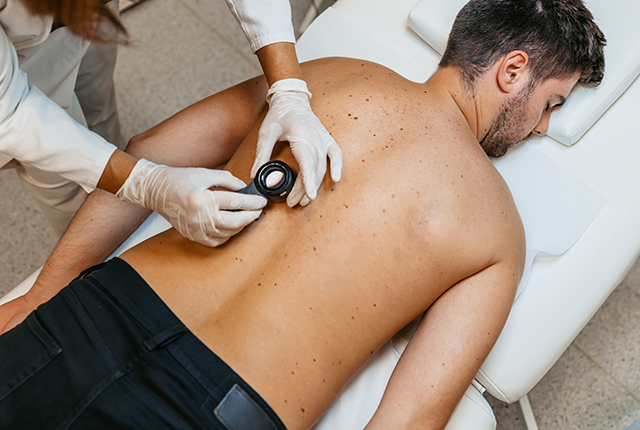
Who will you contact about that worrisome skin lesion?
An analysis of skin cancer diagnoses finds a difference in accuracy between primary-care physicians and dermatologists.Media Contact: Brian Donohue - bdonohue@uw.edu, 206-543-7856

Say you’ve noticed a concerning skin lesion on your body. Would you schedule an appointment with your primary-care physician or seek an opinion from a dermatologist?
After a systematic review of evidence, researchers recently reported that dermatologists showed significantly higher accuracy than primary-care physicians in diagnosing melanoma skin cancers. Diagnoses in which the clinician also used a dermatoscope — a handheld magnifying glass and light — were more accurate than those made without the device.
Should the findings, published last month in JAMA Dermatology, direct your choice of physician to examine that worrisome lesion?
Not necessarily, said the paper’s lead author, Jennifer Chen. She’s a research fellow in dermatology at the University of Washington School of Medicine. She pursued the study in her previous role at the University of California, San Francisco.
The study shows that primary-care physicians diagnose the most common types of skin cancers, basal cell and squamous cell cancers, with accuracy similar to dermatologists. However, melanomas are more difficult to diagnose. Patients whose risk is higher for melanoma — based on previous diagnoses, sunburns, use of tanning beds, or a family history of skin cancer — would benefit from seeing a dermatologist for their screenings.
Chen also drew a distinction between diagnosis and case management.
“A PCP [primary-care physician] might see a lesion and determine that it’s most likely benign,” she said. “But doctors usually will consider two or three potential diagnoses, so even if the initial presentation leads a PCP to identify the lesion as benign, if there’s any uncertainty or the patient is worried, they also can easily refer the patient to a dermatologist or have an e-consult with a dermatologist.”
She emphasized, too, that the vast majority of lesions seen in primary care are benign.
Another reason to seek an opinion from a primary-care physician, Chen said, is the relative scarcity of dermatologists practicing in the United States. There are around 12,500, compared with more than 250,000 primary-care doctors. You’ll probably be seen sooner in a primary-care clinic.
Chen and colleagues analyzed 100 previous studies, reviewing physicians’ experience and their diagnoses of melanomas and keratinocytic (e.g., basal and squamous cell) carcinomas.
When experienced dermatologists had access to patient exams or images of melanomas, their diagnoses’ sensitivity and specificity were 76.9% and 89.1%, respectively, versus 37.5% and 84.6% for primary-care physicians. (Sensitivity and specificity are measures of how well a diagnostic test accurately identifies a disease’s presence or absence.) With keratinocytic carcinomas, the sensitivity and specificity of dermatologists’ diagnoses were 79.0% and 89.1%, respectively, versus 81.4% and 80.1% for primary-care doctors.
When dermatologists used a dermatoscope in the exams, odds of those diagnoses being accurate grew by 2.5-fold with keratinocytic carcinomas and 5.7-fold with melanomas.
Asked how dermatologists determine at what point to use a dermatoscope, Chen said, “Training in dermatology has only recently included dermoscopy. For dermatologists trained in dermoscopy, they will use it routinely.”
Chen said she thought the study data could inform how medical residents in dermatology and primary-care are trained to examine lesions, and help establish benchmarks to guide trainees’ diagnostic training.
For details about UW Medicine, please visit https://uwmedicine.org/about.